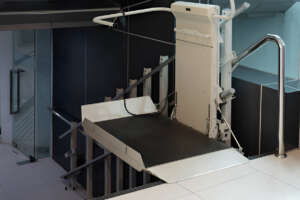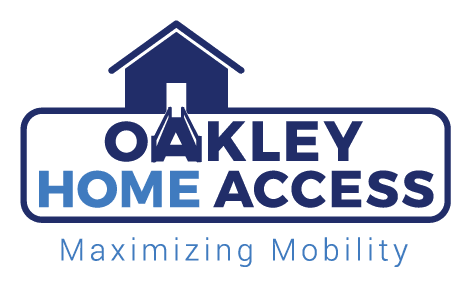What Is a Vertical Platform Lift and How Does It Work
For individuals with mobility challenges, ensuring easy access to different levels of their home or business is essential. Vertical platform lifts are suitable for both outdoor or indoor applications, highlighting their versatility. A vertical platform lift (VPL) provides a safe and efficient solution to overcome barriers like stairs. If you’re considering installing a vertical platform lift, this guide will help you understand what it is, how it works, and why it’s a valuable addition to any property.
What Is a Vertical Platform Lift?
A vertical platform lift, also known as a wheelchair lift, is a mechanical device designed to transport individuals and mobility devices, such as wheelchairs or scooters, between different elevations. Wheelchair lifts are an economical and easy-to-install solution for ensuring ADA compliance and accessibility in commercial buildings. Unlike traditional elevators, VPLs are more compact and cost-effective, making them an ideal choice for residential and commercial properties.

These lifts are commonly used in:
- Residential homes: To provide access between floors or to entrances.
- Commercial buildings: To ensure ADA compliance and improve accessibility.
- Public spaces: To accommodate visitors with mobility needs.
Key Features of a Vertical Platform Lift
- Compact Design: Takes up less space compared to a traditional elevator.
- Safety Features: Includes sensors, emergency stop buttons, and secure platforms.
- Durability: Built to withstand various weather conditions, especially important in Rhode Island’s changing climate.
- Quietest Lift: Some models are known as the quietest lift due to their smooth operation, which is ideal for residential and commercial settings.
Technical Specifications of Vertical Platform Lifts
Vertical platform lifts are designed to provide safe and reliable transportation for wheelchair users and mobility devices. The technical specifications of these lifts vary depending on the model and manufacturer, but here are some common features:
- Lifting Capacity: Vertical platform lifts typically have a lifting capacity ranging from 750 pounds (340 kg) to 1000 pounds (450 kg), ensuring they can accommodate both the user and their mobility device.
- Maximum Lift Height: These lifts can reach heights from 53 inches (135 cm) to 171 inches (435 cm), making them suitable for various applications, from garage entry to second story access.
- Platform Size: Standard platform sizes range from 36 inches (91 cm) x 48 inches (122 cm) to 42 inches (107 cm) x 60 inches (152 cm). Optional platform sizes custom can be tailored to meet specific needs.
- Drive System: Vertical platform lifts use either an Acme screw direct drive or a hydraulic drive system, both known for their reliability and smooth operation.
- Power Source: These lifts can be powered by electricity or a battery, ensuring they remain operational even during a power outage.
- Speed: The lift speed typically ranges from 10 to 20 feet per minute (3 to 6 meters per minute), providing a quick and efficient ride.
- Safety Features: Common safety features include an emergency stop switch, under-platform obstruction detection, and an anti-skid floor surface, all designed to ensure a safe and stable lift experience.
How Does a Vertical Platform Lift Work?
A vertical platform lift operates similarly to an elevator but with a simpler mechanism. Here’s how it works:
- Platform: The user rolls their wheelchair or mobility device onto the platform.
- Controls: The lift is operated using easy-to-use controls, such as buttons or a remote.
- Hydraulic or Electric Mechanism: The lift uses either a hydraulic or electric system to raise and lower the platform.
- Safety Sensors: The lift is equipped with sensors to detect obstacles and ensure a safe ride.
The lift moves vertically along a guide rail, stopping at the designated floor or entrance. Most vertical platform lifts can handle a capacity of up to 750 pounds, accommodating both the user and their mobility device.
Types of Vertical Platform Lifts Available in New London, CT
When choosing a vertical platform lift, there are several types to consider:
1. Enclosed Vertical Platform Lift
- Fully enclosed with walls and a roof for added safety.
- Ideal for outdoor use in areas with harsh weather conditions.
2. Open Vertical Platform Lift
- Open sides with guardrails for protection.
- Suitable for indoor use or areas with minimal weather exposure.
3. Portable Vertical Platform Lift
- Easily moved from one location to another.
- Great for temporary needs or events.
Safety Features and Emergency Stop Systems
Safety is a top priority when it comes to vertical platform lifts. Here are some common safety features and emergency stop systems found in these lifts:
- Emergency Stop Switch: This manual switch can be activated in case of an emergency to stop the lift immediately, ensuring the safety of the user.
- Under-Platform Obstruction Detection: Sensors detect any objects or people under the platform and stop the lift to prevent accidents, providing an additional layer of safety.
- Anti-Skid Floor Surface: The platform is equipped with a textured surface that provides traction and prevents slipping, ensuring a secure ride for wheelchair users.
- Safety Gates: These gates prevent users from entering or exiting the lift while it is in motion, reducing the risk of falls or injuries.
- Alarm System: An audible alarm sounds in case of an emergency or malfunction, alerting users and bystanders to potential issues.
- Backup Power System: A battery-powered system allows the lift to operate during a power outage, ensuring continuous accessibility.
Customization and Configuration Options
Vertical platform lifts can be customized and configured to meet specific needs and requirements. Here are some common options:
- Optional Platform Sizes: Custom sizes are available to accommodate specific needs, ensuring the lift fits perfectly within the designated space.
- Same Side Entry-Exit: This configuration allows users to enter and exit the lift from the same side, providing a straightforward and convenient experience.
- 90-Degree Adjacent Access: Users can enter and exit the lift at a 90-degree angle, which can be particularly useful in tight spaces or specific architectural layouts.
- Pass-Through Access: This configuration allows users to pass through the lift without having to turn around, making it ideal for continuous movement between levels.
- Custom Colors and Materials: Options for customizing the color and material of the lift are available to match specific decor or branding, enhancing the aesthetic appeal.
- Additional Safety Features: Additional safety features, such as extra safety gates or alarm systems, can be added to further enhance the security and functionality of the lift.
By understanding these technical specifications, safety features, and customization options, you can choose the ideal vertical platform lift that meets your specific needs and ensures a safe, reliable, and convenient solution for improved accessibility.
Why Choose a Vertical Platform Lift Installation
Residents and businesses can benefit from working with Oakley Home Access who understand the unique accessibility needs of the community. Choosing a professional installation team ensures your lift meets all safety regulations and is customized to fit your space.
Oakley Home Access also provide ongoing maintenance and support, ensuring your vertical platform lift remains in excellent condition for years to come.
Vertical Platform Lift Maintenance Tips
To keep your vertical platform lift running smoothly, follow these maintenance tips:
- Regular Inspections: Schedule routine checks to identify any wear and tear.
- Clean the Platform: Keep the platform free of debris and dirt.
- Lubricate Moving Parts: Ensure all mechanical parts are well-lubricated.
- Check Safety Features: Test sensors and emergency stop buttons regularly.
By following these tips, you can ensure your lift remains safe and reliable for daily use.
How to Get a Vertical Platform
If you’re ready to enhance your property’s accessibility, there are local providers in New London, RI, that specialize in vertical platform lift installations. Look for companies that offer:
- Free assessment
- Customized solutions
- ADA-compliant installations
- Reliable maintenance services
Working with Oakley Home Access ensures a smooth installation process and ongoing support.
Conclusion
A vertical platform lift is a valuable investment for residents and businesses seeking to improve accessibility and safety. By understanding how these lifts work and their benefits, you can make an informed decision about installing one on your property.
For expert advice and installation services in New London, RI, reach out to a trusted local provider. Ensure your property is accessible to everyone by choosing a reliable vertical platform lift solution.Contact us today.
Frequently Asked Questions (FAQ)
1. What is the cost of installing a vertical platform lift in New London, CT?
The cost of installing a vertical platform lift can vary depending on the type of lift, installation complexity, and customization needs. On average, prices range from $3,000 to $10,000. Contact a local provider in New London, RI for a detailed quote.
2. Are vertical platform lifts safe to use?
Yes, vertical platform lifts are designed with numerous safety features, including emergency stop buttons, safety sensors, and secure platforms, ensuring a safe experience for users.
3. Can vertical platform lifts be used outdoors?
Yes, certain types of vertical platform lifts, such as enclosed lifts, are designed for outdoor use and can withstand various weather conditions.
4. How long does it take to install a vertical platform lift?
The installation process typically takes a few hours to a couple of days, depending on the complexity of the project and the type of lift being installed.
5. Do vertical platform lifts require regular maintenance?
Yes, regular maintenance is essential to keep your lift in good working condition. It is recommended to schedule routine inspections and follow the maintenance tips provided by the manufacturer.
6. Is a permit required to install a vertical platform lift?
Yes, in most cases, a permit is required to install a vertical platform lift. It is advisable to work with a local installer who can help you navigate the permitting process.
